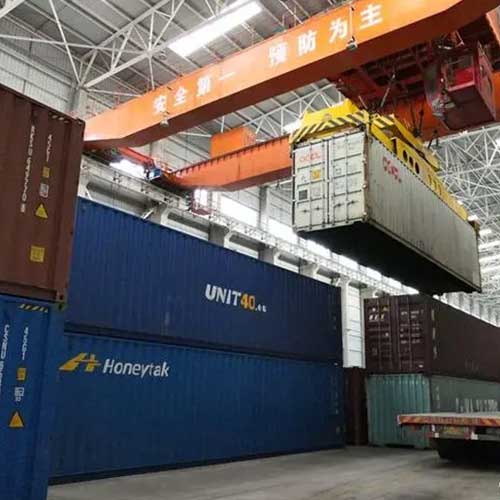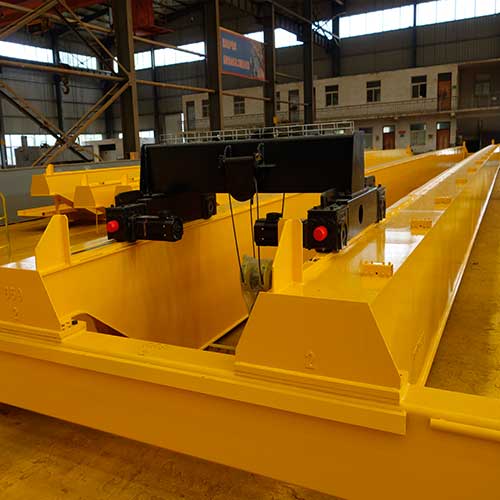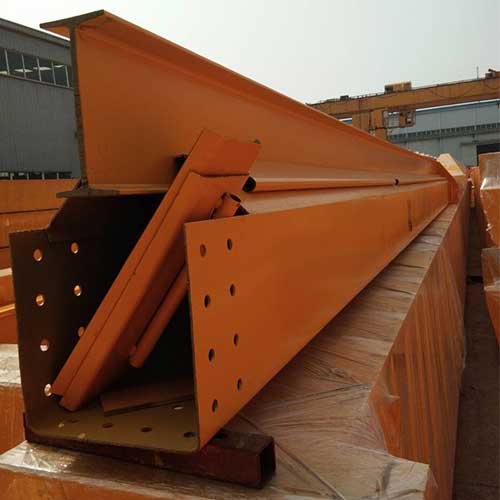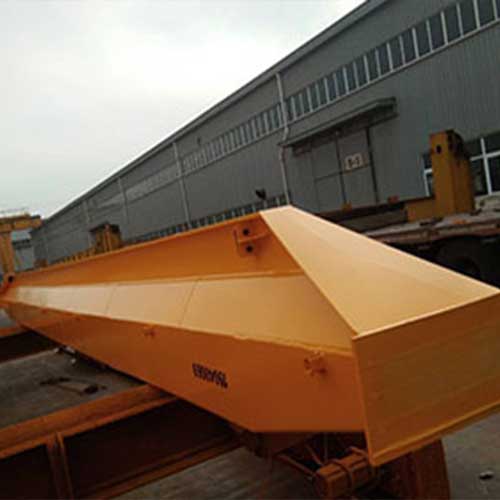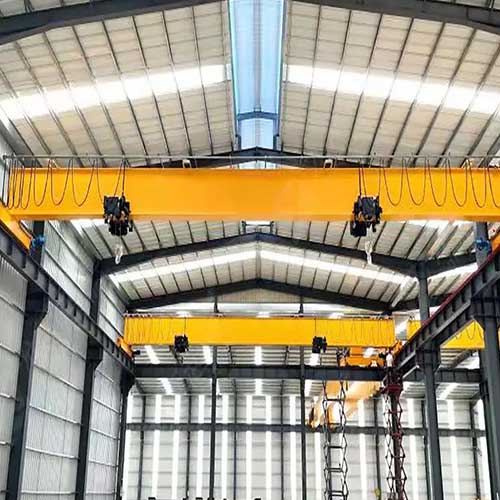Top Running Double Girder Crane, Top Running Crane Buyer Guide
Top running double girder cranes for sale. Custom double girder top running cranes for industrial uses 3 ton, 5 ton, 10 ton, 20 ton, 30 ton to 100 ton.
| Crane type | Top running double girder crane |
| Crane specifications | 3 ton -100 ton |
| Crane span | As your request |
| Lifting height | As customer requirement |
| Note | Customized overhead cranes are providied. |
Category: Top Running Crane
Your Trusted Top Running Crane Manufacturer & Supplier
Top Running Double Girder Crane, Top Running Crane Buyer Guide
Top Running Double Girder Cranes for Sale 3 ton, 5 ton, 10 ton, 20 ton, 30 ton to 100 ton.
Top running double girder cranes for sale. Custom double girder top running cranes for industrial uses 3 ton, 5 ton, 10 ton, 20 ton, 30 ton to 100 ton.
Top Running Double Girder Cranes
A top-running double girder crane is a type of overhead crane commonly used in industrial settings and construction sites for lifting and moving heavy loads. It consists of two parallel bridge girders supported on either side by end trucks, which are mounted on rails or tracks. The crane is designed to operate on an elevated runway system.
Here are some key features and components of a top-running double girder crane:
- Double Girders: This crane type has two horizontal bridge girders that run parallel to each other. The girders provide structural support and house various components such as the trolley and hoist.
- End Trucks: The end trucks are wheeled structures that support the girders and allow the crane to travel along the elevated tracks. These trucks are equipped with wheels that run on the rails.
- Runway System: The crane operates on a dedicated runway system, which consists of rails or tracks installed along the length of the facility. The end trucks move the crane along these rails.
- Trolley: The trolley is a movable mechanism that travels back and forth along the bridge girders. It carries the hoisting mechanism and the load, allowing for horizontal movement of the load.
- Hoist: The hoist is the mechanism responsible for lifting and lowering the load. It is typically mounted on the trolley and is equipped with hooks, chains, or other lifting attachments.
- Controls: Modern double girder cranes are operated using various control methods, including pendant controls, radio controls, or cabin controls. These controls allow operators to precisely maneuver the crane and control the lifting and movement of the load.
Benefits of top-running double girder cranes include:
- Higher Capacity: Double girder cranes generally have a higher lifting capacity compared to single girder cranes due to their more robust structure.
- Greater Span: These cranes can span longer distances between the runways, making them suitable for larger facilities.
- Better Hook Height: The double girder design allows for a higher hook height, which is beneficial when lifting loads to greater heights.
- Durability and Stability: The dual girder design provides increased stability and durability, making them suitable for heavy-duty applications and lifting heavier loads.
- Precise Control: The trolley and hoist can be controlled with high precision, enabling accurate positioning of the load.
Top-running double girder cranes are commonly used in industries such as manufacturing, steel production, automotive, construction, and more, where heavy lifting and precise movement of loads are required.
Here's a classification of the main types of top-running double girder cranes based on crane structures, hoisting systems, crane attachments, and typical applications:
Classification based on Crane Structures:
- a. Box Girder Cranes: These cranes have box-shaped girders, which provide increased strength and stiffness. They are suitable for heavy-duty applications and can handle large loads.
- b. I-Beam Girder Cranes: I-beam girder cranes have a more traditional I-shaped cross-section. They are versatile and commonly used for various lifting tasks.

Box Girder Top Running Double Girder Cranes:
- Typical Capacity Range: High capacity, often ranging from 10 tons to over 500 tons.
- Features: Robust box girder design provides excellent strength and stability. Can be customized with various lifting attachments.
- Benefits: Suitable for heavy-duty applications, long spans, and high-capacity lifting.
- Functions: Lifting and moving extremely heavy loads with precision.
- Applications: Steel mills, heavy manufacturing, shipyards, large-scale construction, power plants.

I-Beam Girder Top Runing Double Girder Bridge Cranes:
- Typical Capacity Range: Varied, typically from 1 ton to 100 tons.
- Features: Versatile and widely used. Can be customized based on specific requirements.
- Benefits: Flexible for various applications, durable design, relatively cost-effective.
- Functions: General material handling, maintenance tasks, versatile lifting.
- Applications: Warehouses, general manufacturing, workshops, automotive industry.
Classification based on Hoisting Systems:
- a. Electric Wire Rope Hoists: These cranes use wire ropes and electric hoists for lifting and lowering loads. They offer precise control and can handle a wide range of loads.
- b. Electric Chain Hoists: Electric chain hoists use chains to lift and lower loads. They are compact, lightweight, and suitable for lighter loads and applications.
- c. Magnet Hoists: Some cranes are equipped with lifting magnets that can handle ferromagnetic materials, making them ideal for industries like steel production.

Electric Wire Rope Hoist Cranes witn Top Running Double Girder Top Runing Cranes Design:
- Typical Capacity Range: Broad range, from 1 ton to 100+ tons.
- Features: Smooth lifting and precise positioning. Suitable for heavy loads and high duty cycles.
- Benefits: Excellent control, adaptable to various lifting needs, reduced wear on ropes.
- Functions: Lifting heavy loads with accuracy, suitable for frequent use.
- Applications: Manufacturing, steel fabrication, heavy equipment production.

Electric Chain Hoist Cranes with Double Girder Top Running Crane :
- Typical Capacity Range: Light to medium duty, often from 1 ton to 20 tons.
- Features: Compact design, easy maintenance, quiet operation.
- Benefits: Lightweight, portable, suitable for lower load capacities.
- Functions: Lifting lighter loads, precise positioning, ergonomic operation.
- Applications: Small workshops, assembly lines, light manufacturing.
Classification based on Crane Attachments:
- a. Grab Bucket Cranes: Equipped with grab buckets, these cranes are used for lifting and transporting bulk materials such as sand, gravel, and agricultural products.
- b. Magnet Cranes: These cranes have lifting magnets for handling materials like steel sheets and scrap in industries such as metalworking and recycling.
- c. Hook Cranes: Standard hook cranes are versatile and can be equipped with various lifting attachments based on the specific load requirements.
- d. Spreader Beam Cranes: These cranes use spreader beams to evenly distribute the load's weight, making them suitable for lifting irregularly shaped loads.

Grab Bucket Cranes with Top Running Double Girder Bridge Crane:
- Typical Capacity Range: Can handle large bulk loads, often from 5 tons to 50+ tons.
- Features: Fitted with grab buckets for efficient bulk material handling.
- Benefits: Quick loading and unloading of loose materials, reduced spillage.
- Functions: Grasping and releasing bulk materials like sand, gravel, and agricultural products.
- Applications: Construction sites, mining, agricultural facilities.

Hook Cranes:
- Typical Capacity Range: Varied, depending on the specific lifting needs.
- Features: Versatile design with hooks for various attachments.
- Benefits: Customizable for different lifting tasks, adaptable to different loads.
- Functions: Lifting and moving various loads based on attachments.
- Applications: General manufacturing, warehouses, construction.

Spreader Beam Cranes with Top Running Bridge Crane :
- Typical Capacity Range: Varies based on the spreader beam design and capacity.
- Features: Equipped with spreader beams for load stability and even distribution.
- Benefits: Prevents load deformation, enhances safety during lifting.
- Functions: Lifting irregularly shaped or delicate loads evenly.
- Applications: Glass manufacturing, construction, heavy machinery installation.
Each type of top-running double girder overhead crane serves specific purposes and excels in certain applications. The capacity range, features, benefits, functions, and applications outlined above should provide a comprehensive understanding of the capabilities and suitability of each type. Keep in mind that customization and technological advancements may introduce variations and enhancements to these crane types over time.
Classification based on Typical Applications:
a. Manufacturing and Warehousing: These cranes are used in manufacturing facilities and warehouses for moving heavy machinery, materials, and products.

Electric Wire Rope Hoist Cranes:
- Typical Capacity Range: 10 tons to 100+ tons.
- Features: Precise lifting, adaptable to manufacturing processes.
- Benefits: Enhanced control, suitable for heavy machinery, production equipment.
- Functions: Lifting and transporting machinery, components, products.
- Applications: Manufacturing plants, assembly lines.

- Typical Capacity Range: 20 tons to 100+ tons.
- Features: Equipped with spreader beams for handling containers.
- Benefits: Efficient loading/unloading of shipping containers from ships and trucks.
- Functions: Transferring containers between various transportation modes.
- Applications: Ports, container terminals.
b. Steel Industry: Cranes with magnet hoists are commonly used in steel mills for handling metal sheets and raw materials.

- Typical Capacity Range: 5 tons to 50+ tons.
- Features: Equipped with lifting magnets for handling steel sheets and scrap metal.
- Benefits: Efficient material handling, reduced manual labor, improved safety.
- Functions: Lifting and transporting heavy steel sheets, coils, and scrap.
- Applications: Steel mills, metal processing plants.
- c. Construction: Cranes in construction sites lift and position heavy building materials, equipment, and structural components.

- Typical Capacity Range: 5 tons to 100+ tons.
- Features: Versatile with various attachments for lifting construction materials.
- Benefits: Adaptable for different construction tasks, enhances productivity.
- Functions: Lifting and positioning building materials, equipment, and structures.
- Applications: Construction sites, building projects.

Grab Bucket Cranes:
- Typical Capacity Range: 10 tons to 50+ tons.
- Features: Fitted with grab buckets for bulk material handling.
- Benefits: Efficient loading/unloading of sand, gravel, concrete, debris.
- Functions: Grasping and releasing bulk construction materials.
- Applications: Construction sites, excavation projects.

Foundries: Foundry cranes are designed to withstand high temperatures and are used for handling molten metal and molds.
- Typical Capacity Range: 5 tons to 50+ tons.
- Features: Heat-resistant components, specialized attachments for molten metal handling.
- Benefits: Withstands high temperatures, facilitates handling of molten metal and molds.
- Functions: Transporting molten metal, moving heavy molds.
- Applications: The casting cranes are typically used in Foundries, casting facilities.
Paper Mills: Cranes in paper mills are designed to handle large paper rolls and facilitate paper production processes.

- Paper Roll Handling Cranes:
- Typical Capacity Range: 10 tons to 50+ tons.
- Features: Specially designed attachments for gripping and handling large paper rolls.
- Benefits: Prevents damage to paper rolls during handling, increases efficiency.
- Functions: Lifting, moving, and positioning paper rolls within the mill.
- Applications: Paper mills, printing facilities.

Electric Wire Rope Hoist Cranes:
- Typical Capacity Range: 10 tons to 50+ tons.
- Features: Precision lifting, suitable for delicate paper rolls.
- Benefits: Controlled lifting and lowering to prevent roll damage, adaptable for various sizes.
- Functions: Lifting and transporting paper rolls during production and storage.
- Applications: Paper mills, paper converting plants.
The paper mill industry requires cranes that can handle large and delicate paper rolls with precision. These cranes are designed to ensure the safety of the paper products while optimizing production and storage processes. The features, benefits, functions, and applications outlined above highlight the specialized nature of top-running double girder cranes used in the paper mill industry.
g. Power Plants: Powerhouse cranes are used for maintenance and installation of equipment like turbines and generators in power plants.

- Typical Capacity Range: 10 tons to 200+ tons.
- Features: Engineered for power plant environments, often with remote controls.
- Benefits: Facilitates installation, maintenance of turbines, generators.
- Functions: Lifting heavy machinery, equipment within power plants.
- Applications: Power generation facilities, turbine halls.

- Typical Capacity Range: 1 ton to 20 tons.
- Features: Compact design suitable for tight spaces within power plants.
- Benefits: Ergonomic operation, ideal for smaller loads and tasks.
- Functions: Lifting equipment, tools, parts for maintenance.
- Applications: Power plants, maintenance areas.
This classification provides an overview of the main types of top-running double girder cranes based on various aspects. Keep in mind that there can be variations and hybrids based on specific industry needs and technological advancements.
Buyer's Guide: Top Running Double Girder Cranes
Top-running double girder cranes are a type of industrial lifting equipment that offer remarkable versatility and strength. Comprising two parallel bridge girders supported by end trucks, these cranes are designed to travel on elevated runways, making them ideal for various industries and applications.
Advantages and Suitability:
These cranes provide several key advantages:
- High Lifting Capacity: Double girder cranes are engineered to handle heavy loads, making them suitable for demanding industrial tasks.
- Extended Span: With their sturdy construction, these cranes can span longer distances between runways, accommodating larger work areas.
- Precise Control: The trolley and hoist systems of double girder cranes enable accurate load positioning, ensuring safe and efficient operations.
- Durability: Built to withstand rigorous usage, these cranes offer exceptional durability, reducing maintenance needs and downtime.
- Flexibility: Double girder cranes can be customized with various attachments, adapting to different lifting requirements.
- Safety: Equipped with advanced safety features like limit switches and overload protection, they prioritize the well-being of both operators and loads.
These cranes find applications across industries such as manufacturing, steel production, construction, ports, and more.
Assessing Your Needs
To make an informed decision about a top-running double girder crane, delve deeper into your specific requirements:
- Defining Lifting Requirements: Clearly define the characteristics of the loads you'll be handling. This includes the weight, dimensions, and nature of the materials. Consider both current and potential future loads.
- Span and Lifting Height: Evaluate the distance between the runways where the crane will operate. Additionally, ascertain the maximum lifting height needed for your tasks.
- Specific Tasks: Identify the operations the crane will undertake. Will it primarily involve lifting and moving loads horizontally, or does it need to perform intricate maneuvers or precise positioning?
By having a comprehensive understanding of your lifting needs, you can narrow down the crane specifications that best align with your intended operations.
Capacity and Span
To make a well-informed decision about your top-running double girder crane, it's essential to grasp the concepts of capacity and span:
- Understanding Crane Capacity: Familiarize yourself with the terms "Safe Working Load" (SWL) and "Rated Capacity." SWL refers to the maximum load a crane can lift under normal operating conditions. Rated capacity accounts for factors like load distribution and structural integrity.
- Choosing Appropriate Crane Capacity: Select a crane with a capacity that comfortably accommodates the heaviest loads you intend to lift. Ensure a safety margin to handle occasional overloads or unexpected variations.
- Determining Required Span: Measure the distance between the runways where the crane will travel. The span must be sufficient to allow the crane to move freely without obstacles.
Balancing capacity and span ensures that your crane can handle loads safely and move within your facility without constraints.
Customization and Attachments
To optimize the crane's functionality for your specific tasks, delve into customization and attachments:
- Attachments: Explore the range of attachments available for the crane. Different attachments, such as hooks, magnets, and spreader beams, expand the crane's versatility and adaptability.
- Special Requirements: If your industry or tasks have unique demands, discuss potential customizations with the crane manufacturer. Custom features can elevate the crane's performance in your specific operational context.
- Exploring Attachments: Investigate the range of attachments available for the crane. Common attachments include hooks for general lifting, magnets for handling ferromagnetic materials, spreader beams for even load distribution, and grab buckets for bulk material handling.
- Assessing Customization Options: Consider how the crane can be tailored to match your specific tasks and industry requirements. This might include modifications to the crane's control systems, structural design, or safety features.
- Future Adaptability: Anticipate potential changes in your operational needs. Ensure that the crane's design allows for future modifications or upgrades. A versatile crane can adapt to shifts in your industry without requiring a complete replacement.
By exploring attachments, assessing customization possibilities, and ensuring adaptability, you maximize the crane's potential in meeting your evolving demands.
Crane Structure and Design
When considering a top-running double girder crane, it's essential to assess its structure and design:
- Comparing Girder Designs: Understand the differences between box girder and I-beam girder designs. Box girders offer superior strength and stiffness due to their closed profile, while I-beam girders are versatile and suitable for various applications.
- Structural Integrity and Durability: Evaluate the crane's overall build quality, welds, and materials used. Ensure that the crane is engineered for heavy-duty use and can withstand the demands of your industry.
- Corrosion Resistance: If your environment involves exposure to moisture or chemicals, inquire about corrosion-resistant coatings or materials. These features enhance the crane's longevity and reliability in corrosive settings.
By comparing girder designs, scrutinizing structural integrity, and addressing potential corrosion concerns, you ensure a crane that can perform reliably in your specific conditions.
Hoisting System and Controls
The hoisting system and control mechanisms significantly impact a top-running double girder crane's performance:
- Electric Wire Rope Hoists vs. Electric Chain Hoists: Understand the differences between these hoisting systems. Electric wire rope hoists offer higher lifting capacities and smoother lifting, while electric chain hoists are compact and suitable for lighter loads.
- Precision and Control: Assess the precision and control required for your tasks. Consider tasks that demand accurate load positioning or delicate handling. Match the hoisting system to your operational needs.
- Control Options: Explore the available control methods. Pendant controls are common and allow operators to control the crane from the ground. Radio controls provide flexibility and allow operators to move freely. Cabin controls offer a dedicated control station on the crane itself.
By choosing the appropriate hoisting system and control options, you ensure efficient and safe crane operations tailored to your tasks.
Safety Features
Safety is paramount when selecting a top-running double girder crane. Focus on the crane's safety features and compliance with industry standards:
- Built-in Safety Features: Examine the crane's safety mechanisms, such as limit switches that prevent over-travel, overload protection to prevent excessive load, and an emergency stop button for immediate shutdown.
- Safety Standards and Regulations: Ensure that the crane meets relevant safety standards and regulations established for your industry. Compliance reflects the manufacturer's commitment to safety and the crane's suitability for safe operation.
Prioritize safety by thoroughly reviewing safety features and confirming compliance with applicable standards to protect both your workforce and assets.
Installation and Runway
Smooth installation and appropriate runway considerations are crucial for optimal crane operation:
- Crane Runway Requirements: Determine the requirements for installing the crane's runway system. This includes the foundation, runway beams, and supporting structures. Consult with the manufacturer or a structural engineer to ensure proper installation.
- Structural Modifications: Evaluate whether your facility needs any modifications to accommodate the crane runway. This might involve reinforcing floors, adding runway beams, or adjusting ceiling heights.
A proper installation and well-designed runway system lay the foundation for safe and efficient crane operations within your facility.
Maintenance and Service
Regular maintenance is essential to ensure the longevity and reliability of your top-running double girder crane:
- Ease of Maintenance: Evaluate how accessible critical components are for maintenance and inspection. A crane with easily accessible parts simplifies maintenance tasks and reduces downtime.
- Spare Parts and Technical Support: Inquire about the availability of spare parts and technical support from the manufacturer. A reliable source of spare parts ensures timely replacements and repairs.
- Maintenance Schedules and Procedures: Understand the recommended maintenance schedules and procedures provided by the manufacturer. Adhering to these guidelines prolongs the crane's operational life and maintains its performance.
Prioritize maintenance and ensure that you have the necessary resources to keep your crane in optimal condition.
Budget and Total Cost of Ownership
The financial aspect of your crane purchase extends beyond the initial cost:
- Initial Cost: Evaluate the crane's price, considering its capacity, features, and customization. Compare prices from different manufacturers to gauge market rates.
- Long-Term Operating Costs: Factor in ongoing expenses, such as maintenance, repairs, energy consumption, and potential downtime. A crane with higher initial quality might result in lower long-term costs.
- Value Assessment: Assess the value proposition of the crane. Compare features, performance, and reliability against the cost to determine the best investment for your needs.
Vendor and Reputation
Choosing a reputable vendor enhances your purchasing experience:
- Research Manufacturers: Investigate the background, reputation, and history of crane manufacturers. Choose companies known for quality, reliability, and adherence to safety standards.
- Customer Reviews and Referrals: Read customer reviews to gain insights into other buyers' experiences. If possible, seek referrals from industry peers who have purchased similar cranes.
- Reliable Products and Services: Ensure the vendor has a track record of providing reliable products and exceptional customer service, including post-sale support.
After-Sales Support and Training
Effective after-sales support contributes to the crane's successful operation:
- Operator and Maintenance Training: Inquire about training programs offered by the manufacturer. Ensure that your crane operators and maintenance personnel receive proper training for safe and efficient operations.
- Customer Support: Check the availability of customer support and technical assistance. A responsive and helpful customer support team can address any concerns or issues that arise during crane use.
A reputable vendor committed to after-sales support and training enhances the overall value of your crane investment.
Compliance and Certification
Ensuring compliance with industry standards and regulations is vital for safety and legality:
- Relevant Standards: Confirm that the crane adheres to industry-specific standards and regulations. Different industries might have distinct safety and performance requirements.
- Certification and Documentation: Verify that the crane comes with proper certification and compliance documentation. This documentation assures you that the crane meets the necessary quality and safety criteria.
Conclusion and Decision Making
With all the information at hand, it's time to finalize your decision:
- Summarize Your Needs: Consolidate your assessment of lifting requirements, capacity, span, customization needs, safety features, and more.
- Evaluate Information: Review all collected data, including pricing, vendor reputation, and after-sales support.
- Informed Decision: Based on the comprehensive evaluation, make an informed decision that aligns with your needs, preferences, and budget constraints.
- Placing the Order: Once you've made your decision, proceed to place your order with the chosen vendor.
By methodically following these steps, you ensure that your investment in a top-running double girder crane is well-considered and aligned with your operational requirements.
Purchasing a top-running double girder crane requires careful consideration and informed decision-making. By following this comprehensive buyer's guide, you'll be equipped to evaluate each aspect of your crane purchase, from initial assessments to final decision-making, leading to a successful acquisition that meets your lifting needs and contributes to your operational efficiency and safety.
Main Projects
Related Products

Supplied three grab bucket crane kits to Indonesia, enhancing garbage handling efficiency with high load capacity and reliable performance.
Free consultation to Confirm Parameters & Specifications and Get
Latest Crane Price & Crane Rate.
- Types of overhead cranes : _______?
- Optional: Overhead travelling crane, goliath gantry crane,Slewing jib crane, Single girder or double girder crane,small portable crane or kbk crane, etc.
- Capacity of overhead crane: _______?
- Optional: 0.25ton, 0.5 ton, 1 ton, 2 ton, 3ton, 5 ton, 10 ton,15ton, 20ton, 25 ton, 30ton,35ton, up to 550ton, etc.
- Crane span & lifting height : _______?
- Crane travelling length : _____?
- Control of overhead crane:_______?
- Optional: pendant/ remote/cabin control
- Voltage supply of overhead crane:_____?
- Eg,: 380V50/60HZ,3Phase or others,etc.
- Application/usage of crane:_______?
- Eg,: Steel mill, ,injection mold, cement,stone, concrete,granite, general manufacturing, etc.
Just leave a message via the contact form and our hoist and crane engineer will contact you with in 24working hours.
Get In Touch
